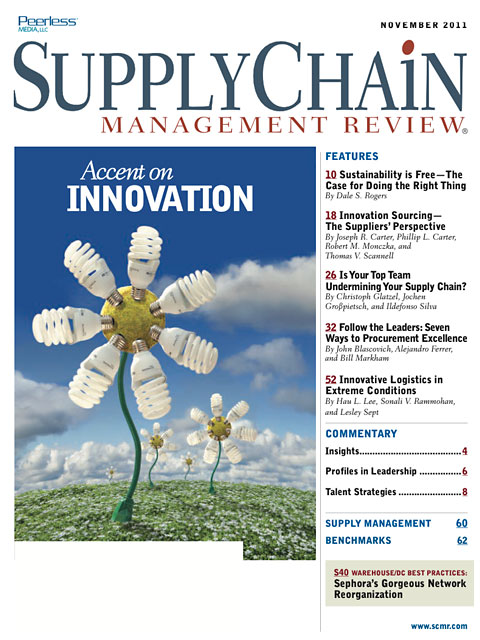Sorry, but your login has failed. Please recheck your login information and resubmit. If your subscription has expired, renew here.
November 2011
Innovation. It’s a hard competency to come by. Can schools teach you to be innovative? Is work experience really the only way to open your eyes to what’s possible? Or is the innovative spark something that lurks in an individual’s DNA—and you either have it or you don’t? Innovation. It’s a hard competency to come by. Can schools teach you to be innovative? Is work experience really the only way to open your eyes to what’s possible? Or is the innovative spark something that lurks in an individual’s DNA—and you either have it or you don’t? Innovation has worked in the Gambia situation and in supplier sourcing. Surely, there must be… Browse this issue archive.Need Help? Contact customer service 847-559-7581 More options
Building a global supply chain to succeed—indeed, to thrive—in a world of rising complexity and uncertainty requires recognizing and tackling significant organizational
challenges. Specifically, the top management team needs to understand that the decisions and activities of their company’s supply chain group affect, and are affected by, the sales team, marketers and product developers, among others. The result is a host of thorny tradeoffs. Should a company, say, move a product to a low-cost manufacturing facility to save money if that means lengthening delivery times? What if trimming the company’s product portfolio to reduce manufacturing complexity and costs could stifle marketing efforts to reach new customers? When do the benefits of improved customer service warrant the additional operating expenses required to deliver it?
Supply chain, sales and marketing managers invariably view such tradeoffs through the lenses of their own responsibilities—and those perspectives often lead to disagreements or misunderstandings. Indeed, a McKinsey survey of global executives cited the inability of functional groups to understand their impact on one another as the most common barrier to collaboration for resolving the major supply chain trade-offs.
Ineffective collaboration has long been a supply chain sore spot, but its costs are set to rise drastically. If it’s hard today to agree on the right response to a disruption in a supply chain, it will be more difficult still when companies deal with multiple interconnected supply chains, each possibly requiring a different solution.
 |
This complete article is available to subscribers
only. Click on Log In Now at the top of this article for full access. Or, Start your PLUS+ subscription for instant access. |
Not ready to subscribe, but need this article?
Buy the complete article now. Only $20.00. Instant PDF Download.
Access the complete issue of Supply Chain Management Review magazine featuring
this article including every word, chart and table exactly as it appeared in the magazine.
SC
MR
Sorry, but your login has failed. Please recheck your login information and resubmit. If your subscription has expired, renew here.
November 2011
Innovation. It’s a hard competency to come by. Can schools teach you to be innovative? Is work experience really the only way to open your eyes to what’s possible? Or is the innovative spark something that lurks… Browse this issue archive. Download a PDF file of the November 2011 issue.
 |
Download Article PDF |
Building a global supply chain to succeed—indeed, to thrive—in a world of rising complexity and uncertainty requires recognizing and tackling significant organizational
challenges. Specifically, the top management team needs to understand that the decisions and activities of their company’s supply chain group affect, and are affected by, the sales team, marketers and product developers, among others. The result is a host of thorny tradeoffs. Should a company, say, move a product to a low-cost manufacturing facility to save money if that means lengthening delivery times? What if trimming the company’s product portfolio to reduce manufacturing complexity and costs could stifle marketing efforts to reach new customers? When do the benefits of improved customer service warrant the additional operating expenses required to deliver it?
Supply chain, sales and marketing managers invariably view such tradeoffs through the lenses of their own responsibilities—and those perspectives often lead to disagreements or misunderstandings. Indeed, a McKinsey survey of global executives cited the inability of functional groups to understand their impact on one another as the most common barrier to collaboration for resolving the major supply chain trade-offs.
Ineffective collaboration has long been a supply chain sore spot, but its costs are set to rise drastically. If it’s hard today to agree on the right response to a disruption in a supply chain, it will be more difficult still when companies deal with multiple interconnected supply chains, each possibly requiring a different solution.
 |
SUBSCRIBERS: Click here to download PDF of the full article. |
SC
MR

Latest Supply Chain News
- How CPG brands can deliver on supplier diversity promises
- How S&OP provides the answer to in-demand products
- AI, virtual reality is bringing experiential learning into the modern age
- Humanoid robots’ place in an intralogistics smart robot strategy
- Tips for CIOs to overcome technology talent acquisition troubles
- More News
Latest Podcast

 Explore
Explore
Latest Supply Chain News
- How CPG brands can deliver on supplier diversity promises
- How S&OP provides the answer to in-demand products
- AI, virtual reality is bringing experiential learning into the modern age
- Humanoid robots’ place in an intralogistics smart robot strategy
- Tips for CIOs to overcome technology talent acquisition troubles
- There is still work to do to achieve supply chain stability
- More latest news
Latest Resources

Subscribe

Supply Chain Management Review delivers the best industry content.

Editors’ Picks





